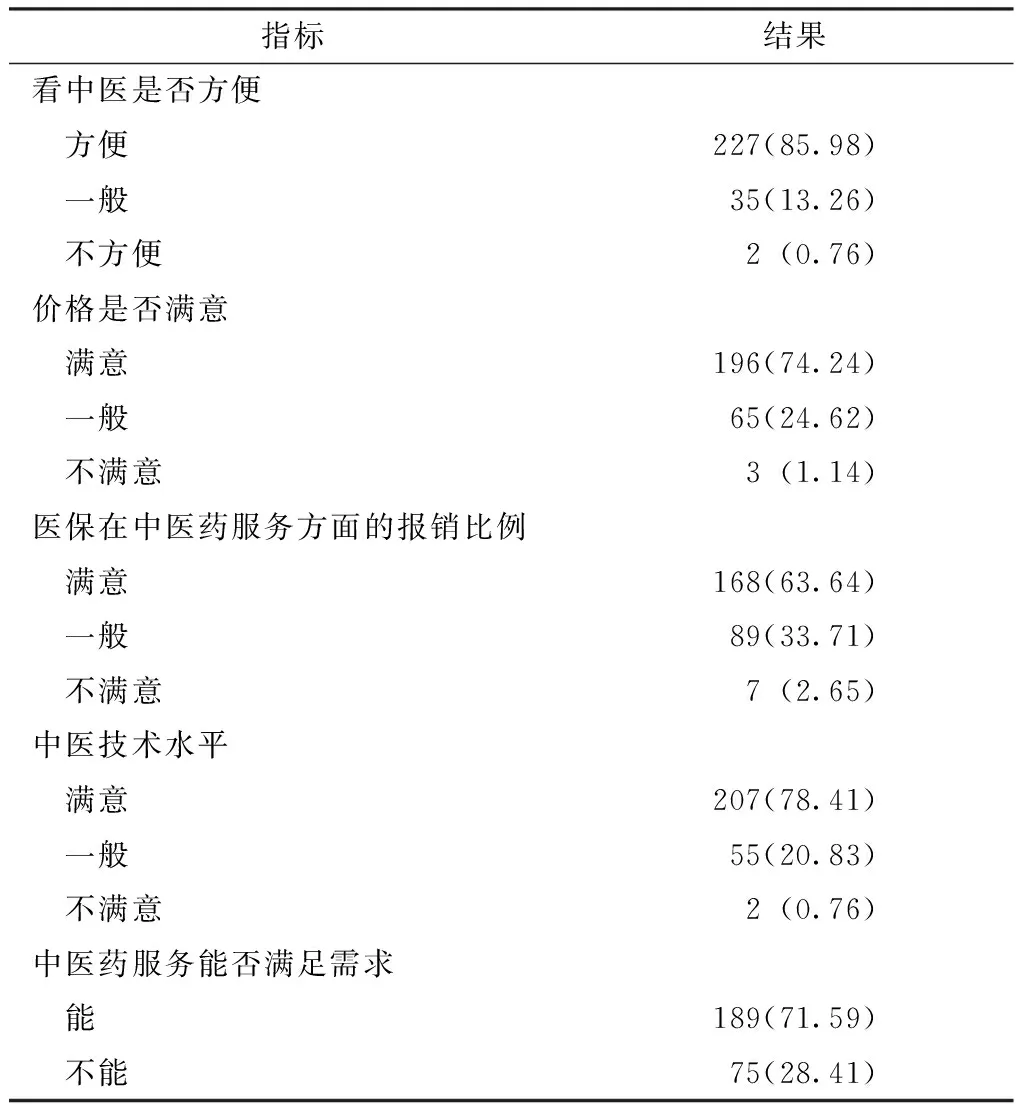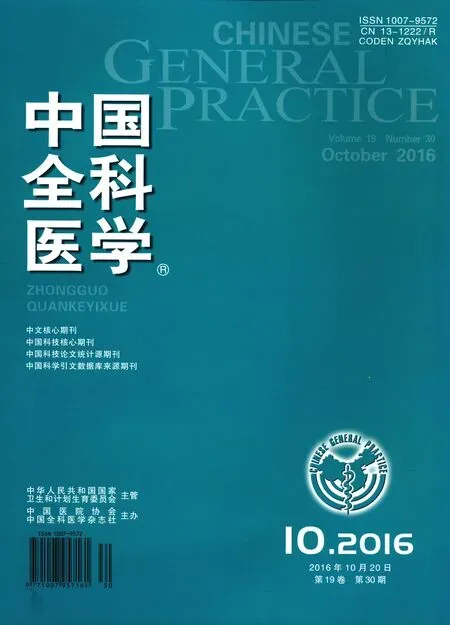社区卫生服务中心中医药服务能力的现状调查
孙 涛,丁小燕,周 巍
·调查研究·
社区卫生服务中心中医药服务能力的现状调查
孙 涛,丁小燕,周 巍
目的了解目前我国中医药服务在基层医疗卫生机构中的开展现状,分析社区卫生服务中心中医药服务存在的问题,为深入、有效开展社区卫生服务中心中医药服务提出政策建议。方法2015年10—12月,按照我国东、中、西部地区的区域划分结果,采用目的抽样法在东、中、西部地区分别随机抽取2个省/直辖市(浙江省、北京市)、1个省(安徽省)、2个省(四川省、贵州省),然后在每个省/直辖市随机选取2家社区卫生服务中心作为调查单元。调查社区卫生服务中心服务人口基本情况、社区卫生服务中心中医资源配备情况、社区卫生服务中心中医药服务开展情况。采用方便抽样法抽取10家社区卫生服务中心辖区居民300人进行调查,调查内容包括居民对所在社区卫生服务中心中医药服务的满意度情况。结果10家社区卫生服务中心辖区的户籍人口为769 810人,常住人口920 548人,其中常住老年人128 881人,0~3岁儿童34 954人。10家社区卫生服务中心均按照要求进行了中医科室的设置和建设。10家社区卫生服务中心中,执业医师总数为472人,中医执业医师为158人(33.47%);中医执业医师数占执业医师数总数最高比率为55.56%(5/9),最低比率为11.11%(4/36)。东部、中部、西部地区社区卫生服务中心的中医执业医师数占执业医师总数的34.00%(85/250)、34.00%(17/50)、32.56%(56/172)。10家社区卫生服务中心平均配备中药饮片种类为389种。东部、中部、西部地区社区卫生服务中心平均配备的中药饮片种类分别为435、373、351种。10家社区卫生服务中心均配备中医药服务和中医药适宜技术。10家社区卫生服务中心2014年度门诊量为1 088 929人次,中医门诊量为369 976人次(33.98%);10家社区卫生服务中心中,中医门诊量占门诊总量最高比率为51.30%(41 000/79 922),最低比率为12.00%(4 750/39 583)。东部、中部、西部地区社区卫生服务中心的中医门诊量占门诊总量的33.15%(284 794/859 210)、29.75%(37 066/124 588)、45.77%(48 116/105 131)。10家社区卫生服务中心2014年度12月份5 d门诊处方中,门诊处方总数为10 716张,其中中医药处方数为4 306张(40.18%);10家社区卫生服务中心中,中医药处方量占门诊处方总量最高比率为55.11%(392/675),最低比率为15.17%(22/145)。东部、中部、西部地区社区卫生服务中心的中医药处方量占门诊处方总量的37.09%(2 469/6 657)、32.39%(501/1 547)、53.18%(1 336/2 512)。10家社区卫生服务中心2014年度社区卫生服务中心诊疗总收入28 685万元,其中中医药诊疗总收入6 454.70万元(22.50%);10家社区卫生服务中心中,中医药诊疗收入占诊疗总收入最高比率为57.17%(1 107.93万/1 938万),最低比率为6.34%(102.00万/1 609万)。东部、中部、西部地区社区卫生服务中心的中医药诊疗收入占诊疗总收入的28.40%(4849.46万/17 073万)、26.48%(169.20万/639万)、13.09%(1 436.04万/10 973万)。10家社区卫生服务中心平均开展的中医药适宜技术种类为9种。8家(东部地区4家,中部、西部地区各2家)社区卫生服务中心开展了孕产妇的中医药健康管理服务,9家(东部地区4家、中部地区2家、西部地区3家)社区卫生服务中心开展了高血压患者和糖尿病患者的中医药健康管理服务。10家社区卫生服务中心均开展了老年人体质辨识服务和儿童中医药调养服务。300份调查问卷中有效调查问卷264份,有效调查率为88.0%。85.98%的居民认为到社区卫生服务中心看中医较为方便;74.24%的居民对社区卫生服务中心的中医药服务价格满意;63.64%的居民对医保在中医药服务方面的报销比例满意;78.41%的居民对社区卫生服务中心的中医技术水平满意;71.59%的居民认为社区卫生服务中心提供的中医药服务能满足其基本需求。结论10家社区卫生服务中心均按照要求进行了中医科室的设置和建设,且均配备中国医药服务及中医药适宜技术,东部、中部、西部地区社区卫生服务中心的中医执业医师所占比率均在32.00%以上,中医门诊量所占比率均在29.00%以上,中医药处方量所占比率均在32.00%以上,中医药诊疗收入所占比率均在26.00%以上,说明我国社区卫生服务中心中医药服务网络正在逐步健全、功能正在逐渐完善,但目前仍存在东部、中部、西部地区发展不平衡等问题,且居民对社区卫生服务中心中医药服务满意比例仍有待提高。
中医药机构;社区卫生服务;病人满意情况
孙涛,丁小燕,周巍.社区卫生服务中心中医药服务能力的现状调查[J].中国全科医学,2016,19(30):3756-3761.[www.chinagp.net]
SUN T,DING X Y, ZHOU W.Current situation of service ability of traditional Chinese medicine in community health service centers[J].Chinese General Practice,2016,19(30):3756-3761.
中医药在预防、保健、养生、康复等方面具有综合优势[1],因此继承和发扬中医药简、便、验、廉的特色和优势,提高中医药的服务能力和水平,是缓解群众“看病难、看病贵”问题的有效途径[2-3]。近年来,国内的中医药行业得到了迅速发展,并越来越受到认可[4]。2009年《国务院关于扶持和促进中医药事业发展的若干意见》[5]中提出要在基层开展中医药服务,并在基本公共卫生服务项目中融入中医药健康管理,在疾病预防与控制中积极运用中医药方法和技术。2015年,国务院办公厅印发中医药健康服务发展规划(2015—2020年)的通知,要求力争使所有社区卫生服务机构、乡镇卫生院和70%的村卫生室具备中医药服务能力[6]。社区卫生服务中心中医药服务的发展对于提升基层医疗服务能力、实现中医药事业的持续发展具有十分重要的意义[7]。本研究选取我国5个省/直辖市的10家社区卫生服务中心作为调查单元,了解目前我国中医药在基层医疗卫生机构中的开展现状以及存在的问题,为深入、有效地开展社区卫生服务中心中医药服务提出政策建议。
1 对象与方法
1.1调查单元2015年10—12月,按照我国东、中、西部地区的区域划分结果,采用目的抽样法在东、中、西部地区分别随机抽取2个省/直辖市(浙江省、北京市)、1个省(安徽省)、2个省(四川省、贵州省),然后在每个省/直辖市随机选取2家社区卫生服务中心作为调查单元。
1.2社区卫生服务中心调查在相关文献研究[8-10]基础上自行设计调查问卷,并经预调查修改后发放。在以上10个调查单元进行调查。调查问卷的主要内容包括:(1)社区卫生服务中心服务人口基本情况,如辖区户籍人口、常住人口、老年人数、0~3岁儿童数等,其中常住定义为在调查地居住6个月以上,老年人以年龄>60岁为界定;(2)社区卫生服务中心中医资源配备情况,主要为中医科室设置、中医人员配备、中医药品与设备配备等情况;(3)社区卫生服务中心中医药服务开展情况,包括中医门诊量、处方及收入情况,中医药适宜技术及中医健康管理服务开展情况。
1.3居民调查采用方便抽样法抽取10家社区卫生服务中心辖区居民300人进行调查,调查内容包括居民对所在社区卫生服务中心中医药服务的满意度情况,包含社区卫生服务中心中医药服务的方便性、价格、医保报销比例、中医技术水平及中医药服务能否满足需求等问题,回收有效问卷进行分析,其中有效问卷是指居民对问卷中每个问题均未做出多选或漏选。
1.4统计学方法采用EpiData 3.1软件录入数据,采用SPSS 17.0统计学软件进行描述性分析。
2 结果
2.1社区卫生服务中心服务人口基本情况10家社区卫生服务中心辖区的户籍人口为769 810人,常住人口920 548人,其中常住老年人128 881人、占常住人口14.00%,0~3岁儿童34 954人、占常住人口3.79%。
2.2社区卫生服务中心中医资源配置情况
2.2.1中医科室设置情况10家社区卫生服务中心均按照要求进行了中医科室的设置和建设,均设置了中医科、中医综合服务区,均配备中药房,且可提供中药煎药服务。
2.2.2中医人员配备情况10家社区卫生服务中心中,执业医师总数为472人,中医执业医师为158人(33.47%);10家社区卫生服务中心中,中医执业医师数占执业医师总数最高比率为55.56%(5/9),最低比率为11.11%(4/36),仅有1家社区卫生服务中心的中医执业医师数未达到社区卫生服务中心执业医师总数的20.00%。东部地区社区卫生服务中心的中医执业医师数占执业医师总数的34.00%(85/250),中部地区为34.00%(17/50),西部地区为32.56%(56/172)。
2.2.3中医药品与设备配备情况10家社区卫生服务中心平均配备中药饮片种类为389种,最多为714种,最少为310种。东部地区社区卫生服务中心平均配备的中药饮片种类为435种,中部地区为373种,西部地区为351种。10家社区卫生服务中心均配备中医药服务和中医药适宜技术的针灸针、火罐、刮痧板、理疗仪等诊疗设备,中药房均有中药调剂台、中药斗柜、煎药机、戥子等。
2.3社区卫生服务中心中医药服务开展情况
2.3.1中医门诊量、处方及收入情况10家社区卫生服务中心2014年度门诊量为1 088 929人次,中医门诊量为369 976人次(33.98%);10家社区卫生服务中心中,中医门诊量占门诊总量最高比率为51.30%(41 000/79 922),最低比率为12.00%(4 750/39 583)。东部地区社区卫生服务中心的中医门诊量占门诊总量的33.15%(284 794/859 210),中部地区为29.75%(37 066/124 588),西部地区为45.77%(48 116/105 131)。
10家社区卫生服务中心2014年度12月份5 d门诊处方中,门诊处方总数为10 716张,其中中医药处方数为4 306张(40.18%);10家社区卫生服务中心中,中医药处方量占门诊处方总量最高比率为55.11%(392/675),最低比率为15.17%(22/145)。东部地区社区卫生服务中心的中医药处方量占门诊处方总量的37.09%(2 469/6 657),中部地区为32.39%(501/1 547),西部地区为53.18%(1 336/2 512)。
10家社区卫生服务中心2014年度社区卫生服务中心诊疗总收入28 685万元,其中中医药诊疗总收入6 454.70万元(22.50%);10家社区卫生服务中心中,中医药诊疗收入占诊疗总收入最高比率为57.17%(1 107.93万/1 938万),最低比率为6.34%(102.00万/1 609万)。东部地区社区卫生服务中心的中医药诊疗收入占诊疗总收入的28.40%(4849.46万/17 073万),中部地区为26.48%(169.20万/639万),西部地区为13.09%(1 436.04万/10 973万)。
2.3.2中医药适宜技术及中医健康管理服务开展情况10家社区卫生服务中心平均开展的中医药适宜技术种类为9种,开展的中医药适宜技术最多为11种,最少为6种。8家(东部地区4家,中部、西部地区各2家)社区卫生服务中心开展了孕产妇的中医药健康管理服务〔包括提供科学、规范的妊娠期(早期、中期、晚期)、产褥期、哺乳期中医药预防保健建议〕,9家(东部地区4家、中部地区2家、西部地区3家)社区卫生服务中心开展了高血压患者和糖尿病患者的中医药健康管理服务〔采用高血压(2型糖尿病)特定中医问诊量表对病患者进行辨证分型,并提供相应的中医养生与治疗综合建议,供医生参考,便于基层开展慢性病管理〕。10家社区卫生服务中心均开展了老年人体质辨识服务(为“国家基本公共卫生服务项目”中免费提供内容),平均为50.61%(65 227/128 881)的65岁以上老年人提供了中医体质辨识服务。10家社区卫生服务中心均开展了儿童中医药调养服务(按儿童月龄的不同,提供针对性的中医饮食调养、起居指导、常用穴位按揉、摩腹、捏脊等中医保健方法),平均为49.69%(17 367/34 954)的0~3岁儿童提供了中医药调养服务。
2.4居民对中医药服务的满意度情况300份调查问卷中有效调查问卷264份,有效调查率为88.0%。85.98%的居民认为到社区卫生服务中心看中医较为方便;74.24%的居民对社区卫生服务中心的中医药服务价格满意;63.64%的居民对医保在中医药服务方面的报销比例满意;78.41%的居民对社区卫生服务中心的中医技术水平满意;71.59%的居民认为社区卫生服务中心提供的中医药服务能满足其基本需求(详见表1)。
表1居民对社区卫生服务中心中医药服务满意度调查 〔n(%),n=264〕
Table 1Survey of residents′ satisfaction with traditional Chinese medicine service in CHS centers

指标结果看中医是否方便 方便227(85.98) 一般35(13.26) 不方便2(0.76)价格是否满意 满意196(74.24) 一般65(24.62) 不满意3(1.14)医保在中医药服务方面的报销比例 满意168(63.64) 一般89(33.71) 不满意7(2.65)中医技术水平 满意207(78.41) 一般55(20.83) 不满意2(0.76)中医药服务能否满足需求 能189(71.59) 不能75(28.41)
3 讨论
3.1社区卫生服务中心中医药服务网络逐步健全、功能逐渐完善近年来,随着国家大力扶持社区卫生服务中心中医药服务,开展“创建中医药先进单位活动”、启动中医馆建设项目、推广中医药基本公共卫生服务项目等,中医药服务在基层医疗卫生机构的平台上发展迅速,社区卫生服务中心中医药服务网络逐步健全、功能逐渐完善。本调查数据显示,所有社区卫生服务中心建立了中医科,设立了中药房,均可提供煎药服务,中医门诊量和中医药诊疗收入分别占社区卫生服务中心门诊总量和诊疗总收入的33.98%和22.50%,社区卫生服务中心中医药服务网络较之前有较大改善。魏勃等[11]对河北省社区卫生服务中心中医药服务现状调查发现,仅有82.8%的社区卫生服务中心设有中医科,中医科门诊人次占门诊总人次的12.1%,中医收入占总收入的8.2%。刘春宏等[12]对2008年杭州市社区卫生服务中心中医药服务现状调查分析发现,中医门诊量仅占社区卫生服务中心门诊总量的22.0%。由此可见,经过几年的发展,我国社区卫生服务中心的中医药服务网络正在逐步健全。同时,社区卫生服务中心中医药服务从过去的仅注重开展中医医疗服务转向同时注重开展中医药健康管理等服务。本研究中10家社区卫生服务中心有8家及以上开展了孕产妇、高血压患者、糖尿病患者的中医药健康管理服务,10家社区卫生服务中心均开展了老年人体质辨识服务和儿童中医药调养服务,平均为50.61%的老年人提供了中医体质辨识服务、49.69%的0~3岁儿童提供了中医药调养服务,由此可见,开展中医药健康管理服务的社区卫生服务中心较多、服务内容较广泛、服务人群较高,社区卫生服务中心有效发挥了中医药在预防保健中的优势,符合国家的政策方针。
3.2社区卫生服务中心中医药服务地区发展不平衡本研究调查数据显示,中医执业医师数占执业医师总数最高比率为55.56%,最低比率为11.11%;社区卫生服务中心配备中药饮片种类最多为714种、最少为310种;中医药诊疗收入占诊疗总收入最高比率为57.17%,最低比率为6.34%;中医门诊量占门诊总量最高比率为51.30%,最低比率为12.00%;中医药处方量占门诊处方总量最高比率为55.11%,最低比率为15.17%;不同地区社区卫生服务中心在各项指标的差距均达40%左右,差异较大,这不利于我国社区卫生服务中心中医药服务的整体发展。某些地区对社区卫生服务中心中医药服务重视不够,加上原有中医药基础设施、设备较差,中医药人才匮乏等因素,又缺乏有效推进措施,从而影响了社区卫生服务中心中医药服务的发展。因此,政府应加大中医药服务发展迟滞地区的政策扶持,在中医药基础设施建设、内部自身建设、人员培训、宣传等方面进一步加大投入力度,提高社区卫生服务中心中医药服务薄弱地区的中医药服务能力,促进各地区社区卫生服务中心中医药服务的协同发展。
3.3居民对社区卫生服务中心中医药服务满意度情况仍有待提高了解居民对社区卫生服务中心中医药服务的满意度可改进社区卫生服务中心中医药服务的内容和形式,提高中医药服务水平[13]。本调查数据显示,85.98%的居民认为到社区卫生服务中心看中医较为方便,71.59%的居民认为社区卫生服务中心提供的中医药服务能满足其基本需求,居民对社区卫生服务中心的中医药服务价格、医保在中医药服务方面的报销比例、中医技术水平的满意度分别为74.24%、63.64%、78.41%,高于其他研究者的研究结果,如付艾妮等[14]对武汉城区老年人的调查中仅有44.2%的老年人对社区卫生服务中心中医药服务价格满意,18.2%的老年人对社区中医技术水平满意;陈力[15]对经济欠发达地区居民的调查表明患者对社区卫生服务中心中医药服务医保报销水平满意率为49.3%。虽然本次调查结果显示居民对社区卫生服务中心中医药服务的满意度较好,但仍有近30%的居民对社区卫生服务中心中医药服务的技术、价格、报销情况等不满意,如居民反应社区卫生服务中心中医药人员技术不高、青黄不接、人员不稳定,某些中药制剂价格偏高,某些地区纳入医保报销范围的中医医疗服务项目和中药制剂数量偏少。可能是因为一些地区没有考虑中医药的特点来制定鼓励中医药服务发展的政策措施,且长期以来基层医疗卫生社区卫生服务中心条件有限、收入低、个人职业发展空间小,许多优秀人才不愿选择从事中医药工作。因此政府应在中医药服务医保报销、人才引进、人员培训方面给予一定政策倾斜,提高社区中医药服务能力和水平,提高居民对社区卫生服务中心中医药服务的满意度,为社区卫生服务中心中医药服务的繁荣发展和国家正在积极推进的分级诊疗工作奠定良好的基础。
综上,本研究调查了典型地区社区卫生服务中心中医药服务发展现状,显示社区卫生服务中心中医药服务网络正在逐步健全、功能正在逐渐完善,但地区发展不平衡且部分居民对社区卫生服务中心中医药服务满意度有待提高。因此,政府应加大中医药服务发展迟缓地区的政策扶持,提高社区卫生服务中心中医药服务薄弱地区的中医药服务能力,提高居民对社区卫生服务中心中医药服务的满意度。
作者贡献:孙涛进行调查设计与实施、资料收集、撰写论文、成文并对文章负责;丁小燕进行评估、整理;周巍进行质量控制及审校。
本文无利益冲突。
本研究不足之处:
本次调查问卷及访谈对象主要以城市地区为主,且在调查问卷设计时选取的部分指标主观性较强,给结果带来一定的偏倚,建议其他研究者在今后研究中予以注意。
[1]曾靓.上海市浦东新区社区中医药卫生服务需求和满意度评价[J].上海医药,2011,32(3):132-134.
[2]史慧敏,李富和.北京市昌平区社区中医发展现状分析及对策研究[J].中国全科医学,2010,13(26):2962-2963,2966.
SHI H M,LI F H.Status of development of traditional Chinese medicine in communities of Changping District in Beijing and the countermeasures[J].Chinese General Practice,2010,13(26):2962-2963,2966.
[3]郭双莉.社区中医药服务现状与发展对策[J].现代医院,2008,8(6):148-149.
GUO S L.A study on the situaction and development of community chinese medicine service [J].Modern Hospital,2008,8(6):148-149.
[4]盖丽丽.基于人口老龄化的中山市社区中医药服务需求与利用研究[J].防保康复,2012,14(26):325-326.
[5]中华人民共和国中央人民政府.国务院关于扶持和促进中医药事业发展的若干意见[EB/OL].(2009-05-07)[2016-04-13].http://www.gov.cn/zwgk/2009-05/07/content_1307145.htm.
[6] 国务院办公厅.国务院办公厅关于印发中医药健康服务发展规划(2015—2020年)的通知[EB/OL].(2015-04-24)[2016-04-14].http://www.gov.cn/zhengce/content/2015-05/07/content_9704.htm.
[7] 李莹颖,赵凤丹,欧阳亚楠,等.我国社区中医药研究现状的文献计量学分析[J].医学与社会,2015,28(11):61-64.
LI Y Y,ZHAO F D,OUYANG Y N,et al.Bibliometrics analysis on the traditional Chinese medicine in community in China[J].Medicine and Society,2015,28(11):61-64.
[8] 姜威,李宗友,胡艳敏,等.广西、重庆、陕西三省市基层中医医疗机构及人员现状调查与分析[J].中国中医药图书情报杂志,2015,39(1):32-35.
JIANG W,LI Z Y,HU Y M,et al.Investigation and analysis of current situation of grass-roots TCM medical institutions and personnel in Guangxi and Shaanxi provinces,and Chongqing municipality[J].Chinese Journal of Library and Information Science for Traditional Chinese Medicine,2015,39(1):32-35.
[9]赵凤丹.北京市社区卫生服务中心中医药服务现状研究[D].北京:北京中医药大学,2016.
[10]孙墨龙.重庆市中医机构的现状及发展策略研究[D].重庆:重庆医科大学,2012.
[11]魏勃,白璐,白俊清,等.河北省社区卫生服务中心中医药服务现状调查[J].中国全科医学,2014,17(26):3150-3152.
WEI B,BAI L,BAI J Q,et al.Current situation of chinese medicine services in community health service centers in Hebei province[J].Chinese General Practice,2014,17(26):3150-3152.
[12]刘春宏,许亮文,李自明,等.杭州市社区中医药服务现状调查分析[J].卫生经济研究,2009,26 (10):39-41.
[13]李亮,孙晓生.基于PLS的广东社区中医药服务公众满意度研究[J].南京医科大学学报(社会科学版),2012,12(4):246-250.
[14] 付艾妮,朱书秀,祁友松,等.武汉市城区老年人对社区中医药卫生服务的需求及影响因素[J].中国老年学杂志,2014,34(10):2836-2838.
[15] 陈力.经济欠发达地区中医药社区卫生服务质量的影响因素及对策[J].中国中医药现代远程教育,2013,11(8):143-144.
(本文编辑:毛亚敏)
Current Situation of Service Ability of Traditional Chinese Medicine in Community Health Service Centers
SUNTao,DINGXiao-yan,ZHOUWei.
BeijingCommunityHealthServiceManagementCenter,Beijing100053,China
Correspondingauthor:ZHOUWei,NationalHealthandFamilyPlanningCommission,Beijing100191,China;E-mail:zhouweiwei95@163.com
ObjectiveTo study the development status of traditional Chinese medicine in primary health care institutions,and to analyze the existing problems of traditional Chinese medicine service in community health service centers so as to provide policy suggestions for developing traditional Chinese medicine service in community health service centers thoroughly and effectively.MethodsFrom October to December in 2015,according to the division results of China-Eastern region,Central region and Western region,two provinces/municipalities (Zhejiang,Beijing),a province (Anhui),two provinces(Sichuan,Guizhou) were randomly selected from Eastern region,Central region and Western region respectively,and then two community health service centers were randomly selected from each province/municipality as the study unit.The basic situation of service population,equipment situation of traditional Chinese medicine resources,developing situation of traditional Chinese medicine service in community health service centers were investigated.By convenience sampling method,300 residents in areas under administration of 10 community health service centers were investigated.The survey included satisfaction of residents of traditional Chinese medicine service in the local community health service centers.ResultsThe registered population under the jurisdiction of 10 community health service centers was 769 810,the permanent population was 920 548,including 128 881 permanent aged people and 34 954 children aged 0 to 3.The 10 community health service centers had all set up and constructed the department of traditional Chinese medicine in accordance with the requirements.In the 10 community health service centers,the total number of practitioners was 472,and the number of traditional Chinese medicine practitioners was 158 (accounted for 33.47%);the highest rate that the number of traditional Chinese medicine practitioners in the total number of practitioners was 55.56% (5/9),and the lowest rate was 11.11% (4/36).In the community health service centers of Eastern regions,Central regions and Western regions,the average rate of the number of traditional Chinese medicine practitioners in the total number of practitioners was 34.00% (85/250),34.00% (17/50),and 32.56% (56/172) respectively.The average kinds of the 10 community health service centers equipping with traditional Chinese medicine decoction pieces were 389.The average types of the community health service centers in Eastern regions,Central regions and Western regions equipping with traditional Chinese medicine decoction pieces were 435,373 and 351 respectively.The 10 community health service centers were equipped with traditional Chinese medicine service and traditional Chinese medicine appropriate technology.The outpatient quantity of 10 community health service centers in 2014 was 1 088 929,the outpatient quantity of traditional Chinese medicine was 369 976 (33.98%);among the 10 community health service centers,the highest rate of the outpatient quantity of traditional Chinese medicine in the total outpatient quantity was 51.30% (41 000/79 922),and the lowest rate was 12.00% (4 750/39 583).The average rate of the outpatient quantity of traditional Chinese medicine in the total outpatient quantity of community health service centers in Eastern regions,Central regions and Western regions was 33.15% (284 794/859 210),29.75% (37 066/124 588),and 45.77% (48 116/105 131) respectively.In the 5 d outpatient prescriptions in December 2014 of the 10 community health service centers, the total number of outpatient prescriptions was 10 716,of which the number of traditional Chinese medicine prescriptions was 4 306 (40.18%);in the 10 community health service centers,the highest rate of traditional Chinese medicine prescriptions in the total number of outpatient prescriptions was 55.11% (392/675),and the lowest rate was 15.17% (22/145).In the community health service centers of Eastern regions,Central regions and Western regions,the average rate of traditional Chinese medicine prescriptions in total outpatient prescriptions was 37.09% (2 469/6 657),32.39% (501/1 547),and 53.18% (1 336/2 512) respectively.The total income of community health service centers in 2014 of the 10 community health service centers was 286.85 million yuan,of which the total income of traditional Chinese medicine diagnosis and treatment was 64.547 million yuan (22.50%);in the 10 community health service centers,the highest rate of income of traditional Chinese medicine diagnosis and treatment in the total income of diagnosis and treatment was 57.17% (11.079 3 million/19.38 million),and the lowest rate was 6.34% (1.02 million/16.09 million).In the community health service centers of Eastern regions,Central regions and Western regions,the average rate of the income of traditional Chinese medicine diagnosis and treatment in the total income of diagnosis and treatment of was 28.40% (48.494 6 million/170.73 million),26.48% (1.692 million/6.39 million),and 13.09% (14.360 4 million/109.73 million) respectively.The average types of appropriate technologies developing by the 10 community health service centers were 9.8 community health service centers (4 in the Eastern region,2 in the Central region and 2 in the Western region) carried out health management services of traditional Chinese medicine of pregnant and lying-in woman,9 community health service centers (4 in the Eastern region,2 in the Central region and 3 in the Western region) carried out health management services of traditional Chinese medicine of hypertension and diabetes patients.The 10 community health service centers had all developed the recognition service of TCM constitution for the elderly and carried out traditional Chinese medicine nursing services for children.There were 264 effective questionnaires among the 300 questionnaires with an effective response rate of 88.0%.85.98% of residents believed that it is convenient to see doctors of traditional Chinese medicine in community health service centers;74.24% were satisfied with the service price of traditional Chinese medicine in community health service centers;63.64% were satisfied with the reimbursement ratio of medical insurance in traditional Chinese medicine service;78.41% were satisfied with the technological level of traditional Chinese medicine;71.59% deemed that traditional Chinese medicine service provided by community health service centers can meet their basic needs.ConclusionThe 10 community health service centers have all set up and constructed the department of traditional Chinese medicine in accordance with the requirements,moreover they are equipped with traditional Chinese medicine service as well as appropriate technology of traditional Chinese medicine.The rate of practitioners of traditional Chinese medicine accounts for over 32.00% in the community health service centers across Eastern regions,Central regions and Western regions,the outpatient quantity of traditional Chinese medicine occupies over 29.00%,the rate of prescriptions of traditional Chinese medicine is over 32.00%,and the income of traditional Chinese medicine diagnosis and treatment was over 26.00%.The above data indicate that traditional Chinese medicine service in Chinese community health service centers is gradually perfected and its functions is gradually improved,however,there is still problems of regional development imbalance in Eastern regions,Central regions and Western regions,and the ratio of residents satisfied with traditional Chinese medicine service in community health service centers needs improving.
Institution of traditional Chinese medicine;Community health services;Satisfaction situation of patients
国家卫生和计划生育委员会项目——社区中医药服务能力现状研究
100053北京市社区卫生服务管理中心(孙涛);中国社区卫生协会(丁小燕);国家卫生和计划生育委员会(周巍)
周巍,100191北京市,国家卫生和计划生育委员会;E-mail:zhouweiwei95@163.com
R 97.1
A
10.3969/j.issn.1007-9572.2016.30.024
2016-03-19;
2016-08-12)

